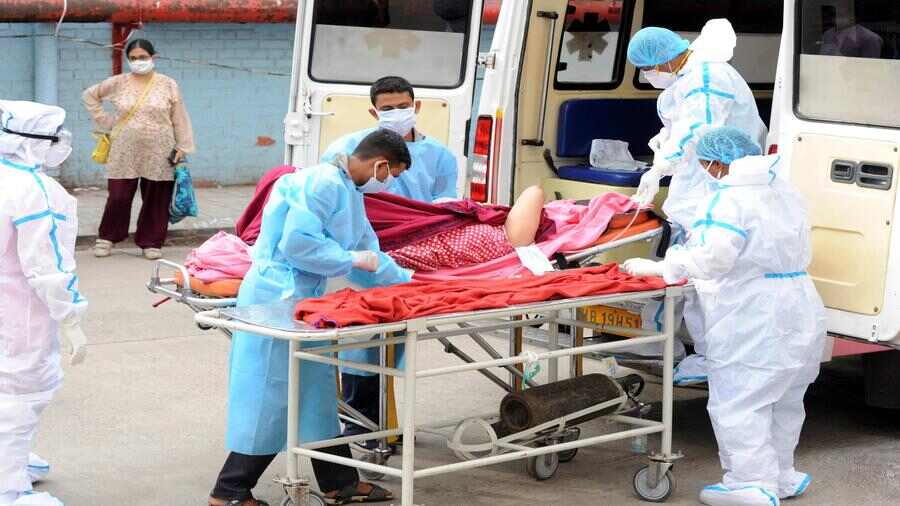India is going through an omicron wave - one is not beking acknowledged, according to ndtv.com.
"While official figures suggest that omicron cases are less than 2 per cent of India's total Covid cases, this could be a massive underestimate," ndtv.com adds.
According to an NDTV review, a major omicron health crisis could hit India very soon and that omicron is now the dominant variant in India.
A total of 1,525 cases of omicron variant of coronavirus have been detected across 23 states and Union Territories so far, out of which 560 have recovered or migrated, according to the Union Health Ministry's data updated on Sunday.
India's Covid tally rose to 3,48,89,132 with 27,553 fresh cases, while the active cases have increased to 1,22,801, according to the data updated at 8 am.
The death toll has climbed to 4,81,770 with 284 more fatalities, the data stated.
The active cases have increased to 1,22,801 comprising 0.35 per cent of the total infections, while the national COVID-19 recovery rate was recorded at 98.27 per cent, the ministry said.
An increase of 18,020 cases has been recorded in the active Covid -19 caseload in a span of 24 hours.
The daily positivity rate was recorded at 2.55 per cent.
The weekly positivity rate was also recorded at 1.35 per cent, according to the ministry.
The number of people who have recuperated from the disease surged to 3,42,84,561, while the case fatality rate was recorded at 1.38 per cent.
The cumulative doses administered in the country so far under the nationwide Covid -19 vaccination drive has exceeded 145.44 crore.
THe NDTV report further adds that India is following the rest of the world in galloping omicron cases, which in some countries, account for 90 per cent of new cases.
"India's official numbers are so low because it has very few testing facilities or labs that can check for genome sequencing which is essential to detecting omicron," the survey states.
NDTV collected data from two labs that are able to test for omicron - and the numbers tell a very different story from what official figures suggest.
"Two major labs, one each in Delhi and in Mumbai, testing for Omicron, show that of all Covid cases, Omicron is now as high as nearly 60 per cent. Another Omicron lab in Mumbai is also likely to show in its next report that Omicron is 60 per cent, up from 37 per cent just a week ago," it adds.
Particularly alarming is the fact that Omicron cases are rising much faster than Delta - from about 2 per cent share of total Covid cases two to three weeks ago, then shooting up to 30 per cent a few days ago- and is now close to 60 per cent of all Covid cases. During this period, the share of the Delta variant has fallen consistently, making Omicron the dominant variant in India.
This is both good news and bad news for India. The good news is that Omicron causes less severe infections than Delta. A higher percentage of Delta patients are hospitalised with a higher percentage of deaths, too, compared with Omicron.
But the worrying news for India is that Omicron spreads much faster - it is estimated to be four to five times more infectious than the Delta variant.
This suggests that if this third wave accelerates in India like it has across the rest of the world, India could see between 16 lakhs to 20 lakh cases every day at its peak compared with the compared with the 4 lakh Delta cases that India had at the peak of our second wave.
This would place an unmanageable strain on our medical system - hospital beds, oxygen cylinders, doctors, and the availability of medicines. This is because even though a fewer percentage of Omicron cases are likely to be hospitalized, the overall number of cases and infections are so much larger.
"Six of 100 Delta cases need hospitalisation, and let's say only half that, three out of 100 Omicron cases need hospitalisation, take a look at the huge consequences: the second wave peaked at four lakh Delta cases, resulting in about 24,000 hospital admissions, and in the worst scenario, a third wave peak of 20 lakh Omicron cases would result in 60,000 Omicron hospitalisations per day," ndtv.com adds.
India's medical infrastructure was close to breaking point during the Delta-driven second wave. With potentially nearly three times that number of hospitalisations under Omicron, India could land in a major health crisis.
India however can hope that the omicron wave, "though much worse than the Delta wave, may not last as long. Data from South Africa shows that Omicron waves tend to both spike faster and die away quicker than Delta waves."










